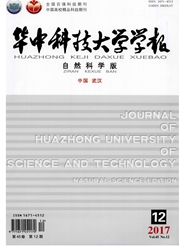

 中文摘要:
中文摘要:
提出了一种采用正交幅度调制(QAM)的差分空时编码协作(DSTCC)方案.在该方案中,中继节点采用选择译码转发(SDF)模式进行协作传输,目的节点利用估计的信道功率对广播阶段和协作阶段的接收信号进行最大比合并.虽然在差分译码过程中接收节点需要估计信道功率和功率归一化系数,但与采用PSK调制的DSTCC方案相比,提出的方案具有更高的信噪比增益.仿真结果显示:在时变信道中,当传输速率大于3 bit/信道时,QAM-DSTCC方案比PSK-DSTCC方案的性能更好.尤其是当传输速率达到6 bit/信道时,QAM-DSTCC方案可以获得5.35 dB的信噪比增益.虽然随着多普勒频率的增加,QAM-DSTCC方案的信噪比增益随之下降,但只要信道功率的估计范围选择合适,仍然可以获得更好的性能.
 英文摘要:
英文摘要:
A differential space time coding cooperation (DSTCC) scheme using quadrature amplitude modulation (QAM) is presented. In the scheme, the selection decode-and-forward (SDF) model is utilized at the relay node for the cooperative transmission and the maximum-ratio combing (MRC) is employed at the receiver node to combine the received signals in the broadcast phase and the cooperative phase. It is required to estimate the channel power and the normalized power factor for the differential decoding, however, the proposed scheme has the advantage of signal-to-noise ratio (SNR) gain compared with conventional DSTCC scheme with PSK modulation. The simulation results demonstrate that QAM-DSTCC scheme outperforms PSK-DSTCC scheme, when the transmission rate is more than 3 bit/channel use. Specially, when the transmission rate is 6 bit/channel use, QAM- DSTCC scheme obtains a 5.35 dB SNR gain. Although the SNR gain decreases as the Doppler frequency increases, QAM-DSTCC scheme can still achieve a better performance than the conventional one, provided the channel power estimation interval is selected suitably.
 同期刊论文项目
同期刊论文项目
 同项目期刊论文
同项目期刊论文
 The Periodic Half-width Microstrip Leaky-Wave Antenna with a Backward to Forward Scanning Capability
The Periodic Half-width Microstrip Leaky-Wave Antenna with a Backward to Forward Scanning Capability A New Time Domain Solution for the Multiple Diffraction of Spherical Waves by an Array of Nonperfect
A New Time Domain Solution for the Multiple Diffraction of Spherical Waves by an Array of Nonperfect Nonbinary LDPC codes constructed based on a cyclic MDS code and a low-complexity nonbinary message-p
Nonbinary LDPC codes constructed based on a cyclic MDS code and a low-complexity nonbinary message-p Linearly time-varying channel estimation and training power allocation for MIMOOFDM systems using su
Linearly time-varying channel estimation and training power allocation for MIMOOFDM systems using su Linearly Time-Varying Channel Estimation and Symbol Detection for OFDMA Uplink Using Superimposed Tr
Linearly Time-Varying Channel Estimation and Symbol Detection for OFDMA Uplink Using Superimposed Tr Optimal Estimation of Linearly Time-Varying MIMO/OFDM Channels Modeled by a Complex Exponential Basi
Optimal Estimation of Linearly Time-Varying MIMO/OFDM Channels Modeled by a Complex Exponential Basi 期刊信息
期刊信息
